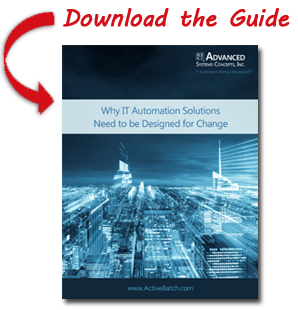In a relatively short time, workload automation has evolved from static job scheduling to a fully architectural solution that spans the breadth of IT Operations. Now, modern automation solutions are swiftly making themselves a valuable resource in today’s emerging areas such as DevOps, cloud computing, and Big Data.
In an effort to measure how top IT decision makers view the changing role of workload automation software in their organizations, Advanced Systems Concepts conducted a survey of CIOs and other IT decision makers at over 100 of the top companies in the United States. Our findings show:
Workload Automation is Now a Core Enterprise Application:
Among those surveyed, 63% —nearly 2-out-of-3 CIO respondents— reported that their automation software is an integral part of their operations and that they individually access it on a daily basis. Nearly 9 out of 10 organizations reported working with automation software at least several times each week.
As businesses increasingly move towards digitalization, IT automation must act as a cornerstone, optimizing resources and workloads in heterogeneous environments composed of diverse applications and technologies.

We anticipate that the steady use of an automation solution will only continue to grow as individuals and departments both inside and outside of Operations will increasingly utilize the rapidly expanding capabilities of modern automation solutions.
As organizations continue to require fast and timely deployment of IT solutions and updates, we foresee a trend in putting the power directly in the employees’ hands.
For example, Human Resources users can now initiate the on-boarding process for new employees, as well as for employees who change roles or leave the organization, by automating the creation of an Active Directory account, assigning them to groups, provisioning resources for a new machine, and setting up an email account as well as distribution lists- all with one click of a button. In addition to reducing the downtime of an employee having to wait for IT to solve their issue or build a workflow, this also takes some of the burden off of IT, allowing them to focus on higher level tasks.
Workload Automation Brings Efficiency to More Processes Than Ever Before:
When asked what types of processes they use their IT automation platform to manage, respondents overwhelmingly chose Scripts as the number one process (mentioned by 85% of respondents). This was followed by Batch Processes (84%), File Operations (77%), Managed File Transfers (73%), Business Processes (68%), IT Operations (64%), Reporting/BI (50%), ETL/Data Warehousing (47%), Data Center Processes/Backups (40%), Runbook Automation (39%), and DevOps/QA/Release Management (17%).
Creating new workflows and maintaining business and IT processes is a key function of most IT departments. Intelligent IT automation simplifies the creation of workflows and is more adaptable to changes in the competitive, regulatory, and business environments that continue to affect companies with increasing velocity.
While scripting is always going to be present, CIOs are using automation capabilities, such as better lifecycle management with revision control, to ensure script integrity and more reliable and secure production environments. In addition to this, with the advent of pre-templated job steps and an Integrated Jobs Library, developers no longer have to perform time-consuming and error-prone custom scripting in order to initiate new processes or fix processes that are defunct because of old scripts.
Although DevOps is lower on the list, it is an emerging movement that is being implemented by a growing number of development and operations teams of all sizes. We think it’s likely that Directors and other IT decision makers will start using automation software to facilitate DevOps and other agile methodologies (SCRUM, Lean, Kanban, etc.).
Automation software can help in the DevOps area by automating build and deploy processes quickly and reliably to enable better collaboration and coordination. For example, organizations using SCRUM can create workflows that generate new stories when tests fail. Once these stories are triaged and prioritized, developers will know right away if they break something, creating a quick feedback loop that makes the development cycle more agile and allows for more visibility and control for the team as a whole.
Based on the proliferation of emerging enterprise technologies and organizations’ need for fast-paced IT solutions, we think the new era of IT automation will be key in simplifying the inherent complexities of digitalized businesses with disparate applications, technologies, and platforms.
Gaze into your crystal ball and comment to let us know where you see the future of workload automation going!

